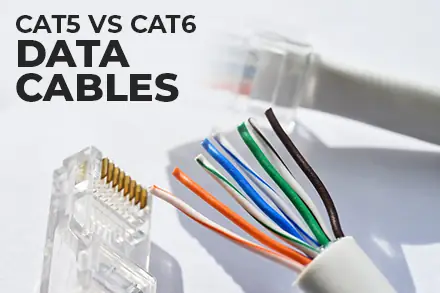What are data cables?
Data cables are purpose designed for connecting devices together for data transfer such as transferring files or syncing data between your phone and computer. They have a range of qualities that are suitable for domestic and commercial applications depending on the category of the data cable. They are ideal for setting up fast, high-quality networks.
Are Ethernet and data cables the same?
Data cables and Ethernet cables are not the same, however, they do have similar uses in network cabling. In addition, Ethernet cables are a type of data cable. Ethernet cables are designed for connecting different types of devices on a network such as computers, routers, and printers. They can supply power to a device and transmit data over short distances.
On the other hand, data cables are designed to connect different Ethernet devices together, sending electrical signals at a high speed. This allows for faster data transmission between Ethernet devices.
Types of Ethernet cables for network cabling:
There are two main categories of Ethernet data cables: Category 5 and Category 6. Both cables are commonly used as network cables for connecting computers, network devices, and devices to modems, servers, and switches. However, a key difference between Cat5 cables and Cat6 cables is that Cat5 cables can support up to 10/100 Mbps at a 100MHz bandwidth whereas Cat6 cables can support up to 1000 Mbps at a higher bandwidth of 250 MHz.
This means that if your local network or incoming internet connection runs at between 10 and 100 Mbps, the Cat5 Ethernet cable should be able to handle the required data at full speed, with no loss or delay.
Overall, Cat6 cables have a better quality data transmission, but that is not the only thing that sets them apart. Before deciding on a Cat5 or Cat6 cable, there are a few key things to consider:
- The required network speed – i.e., 100 Mbps, 1000 Mbps, or 10 Gbps?
- The number of users – this affects the frequency of the cable (MHz).
- The frequency of internet use.
- Whether it is for use indoors or outdoors.
- Possible sources of interference to tackle.
- Whether the cable needs to be rigid or flexible.
Now let’s delve into the unique capabilities of both Cat5 and Cat6 data cables.
Cat5 data cables
With Cat5 cables, the most commonly used type nowadays is the Cat5e (Category 5 enhanced) version which offers improved performance with up to 10 times faster speeds and enhanced ability for longer data transmission distances without being affected by crosstalk. Cat5e cables can also run at 10/100/1000Mbps typically over a distance of 100 Meters.
Cat5 cables are made up of twisted pair cables with annealed solid copper cores and a PVC/LSF outer sheathing construction. This makes them suitable for use in a range of applications thanks to the robust, tough, and abrasion-resistant sheathing material.
Key features of Cat5 cables:
- Designed for high-speed LAN’s including gigabit Ethernet applications – to carry signals for video/data and telephone normally used for LAN Ethernet networks.
- A popular choice for CCTV installations.
- Commonly found supporting incoming internet or broadband connections.
- Can be used for permanent/semi-permanent installations in cabinets and floor wiring.
- Versatile – Can be found in a variety of applications such as home networks, office networks, and audio/video applications.
- Offer high-transfer speeds at a low cost and can transfer up to four signals at once.
- Unshielded Cat5 cables are susceptible to signal noise from wireless devices, which can further reduce data transfer speeds.
- For residential applications – ideal for home and small business applications as it can only have up to 100 Mbps of transfer speed.
Our range of Cat5 Enhanced cables:
The Securi-Flex SFX/C5-UTP-PVC-GRY-305 | Data Cable Cat5e 4 Pairs UTP PVC Grey (305m)
This is a grey Cat5 enhanced cable with a 305m easy reel box. It is an unshielded twisted pair type of data cable that is used to carry signals for data, telephone and video. It is purpose designed for high speed LAN Ethernet networks, including gigabit Ethernet applications, providing performance of up to 100MHz.
The construction of the cable consists of 8 bare copper conductors and a HDPE insulation. These are twisted together forming 4 pairs with varying lay lengths, and then sheathed with a heat resistant PVC material.
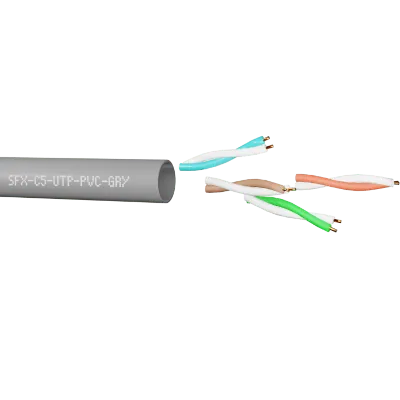
Applications:
- Computer networking and security applications including POE (Power Over Ethernet).
- Useful for laying under carpets and flooring.
- Indoor residential applications – as it can only have up to 100 Mbps of transfer speed.
We also offer this cable with an LSF (low smoke fume) outer sheathing.
The CAT5E LSF 305m UTP Cat5e Enhanced Solid Copper LSF Data Networking LAN/Ethernet Cable
It can be used for permanent or semi-permanent installations in cabinets and floor wiring. Hoowever, a key feature of this cable is its low smoke zero halogen (LSZH) jacket which reduces the volume of toxic and corrosive gases emitted in the case of a fire, making this suitable for use in areas where toxic fumes can be hazardous to the public.
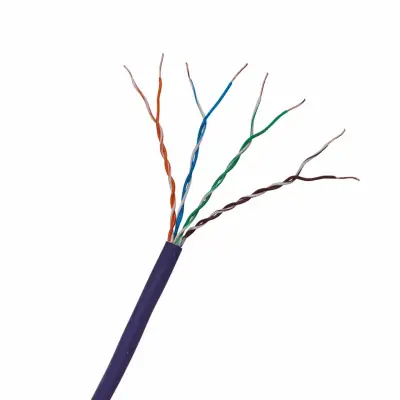
Applications:
- High fire risk areas.
- To carry signals for video/data and telephone normally used for LAN ethernet networks.
- Indoor and outdoor residential applications
The Securi-Flex SFX/C5-UTP-PE-BLK-305 | Data Cable Cat5e 4 Pairs UTP PE Black (305m)
It is designed and tested to achieve Gigabit Ethernet. It is a highly flexible cable consisting of twisted pairs of wires. This is perfect for preventing electromagnetic interference.
It has an external grade robust polyethylene (PE) jacket that is abrasion resistant, UV protected, water-ingress resistant, and robust, making the cable ideal for difficult installations and use in harsh environments, including in exterior applications.
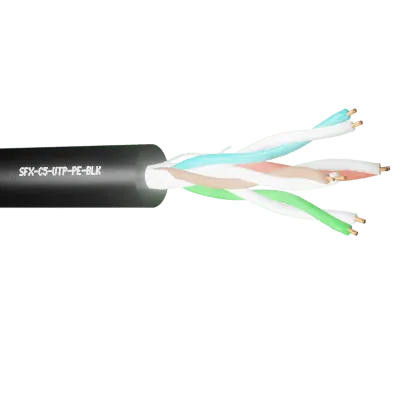
Applications:
- CCTV installations.
- Data and voice applications.
- Indoor and outdoor residential applications, including in harsh conditions.
CAT6
Cat6 cables are an improved version of Cat5e data cables. They are standardised twisted pair cables for Ethernet that are backward compatible with Cat5 and Cat5e cable, however it offers higher data transfer performance, improved resistance to crosstalk, and longer transmission distances.
The cable conductors and sheathing of Cat6 cables are very thick which helps with reducing interior and exterior signals, or EMI interference.
CAT6 data cables can run at the following speeds 10/100/1000/10000, and because CAT6 is a copper core cable, you can only run it up to 100 Meters in total length. They also have a bandwidth capacity of 250 MHz.
Key features of Cat6 cables:
- Help to reduce interior and exterior signal or EMI interference.
- Ideal for networking in industrial settings where motors, generators, or wireless devices could be causing significant signal interference.
- Designed to connect either to a laptop, PC, modem, router, switch, phone, or IP camera.
- Provides faster internet speeds.
- The stiffness/thickness of Cat6 cables makes the cable less flexible and harder to work with which can be an issue if you lack space.
- For commercial applications – installing Cat6 will future-proof your business.
PVC and LSF Cat6 data cables:
We also offer Cat6 cables with PVC and LSF sheathing.
The Securi-Flex SFX/C6-UTP-PVC-GRY-305 | Data Cable Cat6 4 Pairs UTP PVC Grey (305m)
It is an unshielded twisted pair cable designed for use in next generation data communications networks and will comfortably support all present applications including Gigabit Ethernet.
It is a solid conductor 4 pair UTP cable made from a high grade 23AWG copper with a grey PVC outer sheathing. This makes it better suited for indoor installations and settings where there is less risk of fires, and a halogen free cable is not necessary.
This Cat6 PVC cable has a high bandwidth providing performance for up to 250MHz. It also offers incredible signal transmission, faster internet speeds, and reduced interior and exterior or EMI interference.
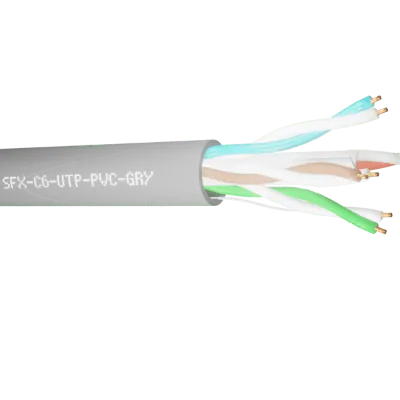
Applications:
- Indoor commercial installations.
- Computer networking and security applications including POE (Power Over Ethernet).
The CAT6 LSF CABLE 305m UTP Enhanced Solid Copper LSF Data Networking LAN/Ethernet Cable
It is a Category 6 unscreened data cable with a low smoke zero halogen outer sheath with a flame-retardant construction which is much safer for humans and nearby appliances as it doesn’t emit chemical gases. It also releases a reduced density of smoke in the event of a fire or exposure to high heat levels. This makes it ideal for commercial installations where there are high risks of fire hazards.
It has a high bandwidth, providing performance up to 250MHz which reduces download and upload times when transferring files. It also has a higher specification for signal transmission and system noise, providing faster internet speeds and reduced crosstalk.
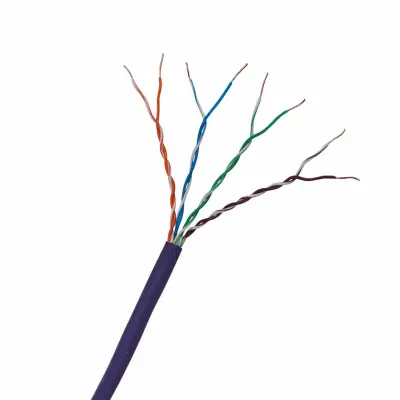
Applications:
- Commercial installations where there are high risks of fire hazards.
- Computer networking and security applications including POE (Power Over Ethernet).
The Securi-Flex SFX/C6-FTP-PE-BLK-305 | Data Cable Cat6 4 Pairs FTP PE Black (305m)
This Cat6 data cable is constructed with a PE outer sheathing, protecting against environmental factors such as moisture, chemicals and physical damage. This cable is UV resistant meaning it can be used above ground or under ground if fitted inside ducting.
It has excellent performance qualities being capable of 1000MBPS or 250MHZ frequency at a maximum distance of 90 metres. This cable is also screened to protect against electromagnetic interference (EMI) for efficient use.
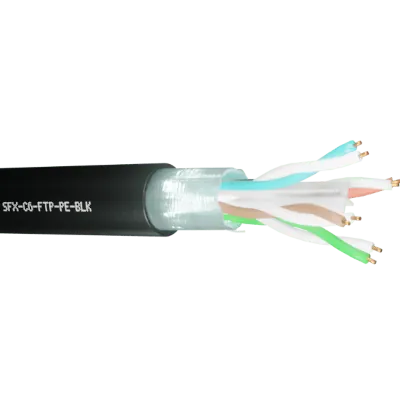
Applications:
- Suitable for indoor and outdoor use.
- Gigabit ethernet networks and other high speed data transmission applications.
In summary, the core differences between Cat5 and Cat6 cables are:
- Bandwidth – CAT6 cables have a bandwidth capacity of up to 250 MHz, compared to 100 MHz for CAT5e. This means that a CAT6 cable can process much more data at the same time (faster data transmission). A higher bandwidth reduces download and upload times, especially when transferring files via a Cat6 cable.
- Speed – CAT6 cables offer speeds up to 10GBASE-T or 10-Gigabit Ethernet, compared to CAT5e cables which can only support up to 1GBASE-T or 1-Gigabit Ethernet.
- Crosstalk (signal transfers that disrupt your communication channels) – CAT6 cables have strict performance specifications for crosstalk and system noise. They provide significantly lower interference or Near-End Crosstalk (NEXT) in the transmission compared to CAT5e. It also improves Equal-Level Far-End Crosstalk (ELFEXT), Return Loss (RL), and Insertion Loss (IL). The result is less system noise, fewer errors, faster internet speeds, and higher data transmission rates.
- Visual – CAT6 cables are stiffer and thicker than CAT5e cables because they use thicker copper wires. This can make it harder to work with especially if you lack space.
Overall, one key thing to remember is that the higher the category number of the cable(CAT), the greater the speed and distance performance.
Hopefully, this blog has answered any questions you have in deciding whether to invest in a Cat5/Cat5e or Cat6 cable for your network needs.

